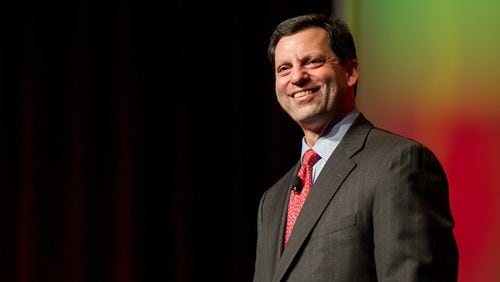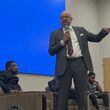TOP THREE EARNERS
Georgia CEOs with the biggest compensation packages in 2015
1. Frank Bisignano, First Data, $51.6 million
2. Martin Flanagan, Invesco, $15.9
3. Richard Anderson, Delta Air Lines, $15.8 million
Each year in proxy filings, companies go on for pages about pegging executive pay to performance measures such as profits and stock returns.
But there didn’t seem to be much of a linkage last year between CEO pay and performance — or even to the firms’ size — at many of Georgia’s 25 largest public companies.
The median raise was 3 percent, to $11.5 million, reflecting another year of profit headwinds and modest stock returns. The median profit and stock gains were 9 percent and 4 percent, respectively.
The biggest pay package, meanwhile, went to a CEO whose “fintech” company lost money and saw its share price drop. Another at an airline with record profits took a cut in compensation.
CEO pay has been a hot-button topic among both investors and politicians in recent years, as executives’ pay soared to hundreds of times more than most workers’ while household incomes flat-lined. One result: federal legislation after the Great Recession requiring all public companies to hold “say-on-pay” votes on executive pay, though they are nonbinding.
» PHOTOS: Who are Georgia's highest-paid CEOs? Find out here.
The AJC examined filings from the state’s biggest public companies to see how CEOs fared in various types of compensation, which usually include cash pay, bonuses and payouts based on stock performance. Data was compiled by Equilar, a California-based compensation analysis firm.
Among the findings:
— Total compensation for the highest-paid CEO, Frank Bisignano of First Data, jumped more than 450 percent, to almost $51.6 million, mostly because of stock awards valued at nearly $40 million that are tied to the company’s initial public offering last year. The Atlanta payments processor’s loss tripled last year to $1.5 billion, and its stock is down since the IPO. The latest raise bumped Bisignano’s total pay since 2013 to $137 million.
— CEO pay moved in opposite directions from profits or stock returns at almost half of the companies. NCR’s Bill Nuti got a 29 percent pay raise, to $11.9 million, despite the firm’s drop to a $178 million loss. On the other hand, former Delta Air Lines CEO Richard Anderson took a 10 percent pay cut, to $15.8 million, despite profits that soared to $4.5 billion.
— Among the 10 most profitable and generally largest Georgia firms, CEOs took pay cuts at six, perhaps reflecting investors’ concern about longer-term trends and growing pressure from “say on pay” votes. Coca-Cola CEO Muhtar Kent took a 42 percent pay cut, to $14.6 million, as the company’s profit and revenue lagged and last year’s say-on-pay approval fell more than 10 percentage points from the previous year.
— On the other hand, CEOs at some mid-sized companies got huge pay raises — equal to a significant chunk of their firms’ profit growth — that left them better paid than CEOs at much bigger firms. For instance, lighting manufacturer Acuity Brands CEO Vernon Nagel got almost $14.8 million last year, a 90 percent bump, making him the fourth highest-paid CEO in the state last year. CEOs at some other mid-sized firms, Global Payments, another payments processor, and Veritiv, a packaging company, also got huge pay raises that mirrored profit growth and lifted their pay into the big leagues.
So what’s going on with all these zigging and zagging pay packages?
“The thing about executive pay is it’s forward-looking,” said Dan Marcec, director of content at Equilar.
Companies’ boards of directors put together CEO pay packages that try to accomplish several things at once: retain talent; encourage CEOs to focus on improving company performance; and pay in ways, such as stock awards that phase in over a few years, that align CEOs’ interests with those of shareholders.
About 70 percent of executives’ performance-based pay is stock or option awards tied to a three-year timeline, typically, that may not match up with companies’ fortunes from year to year, said Marcec. The balance is usually annual cash salary and bonuses, plus perks and benefits such as a pension and use of the company jet.
As a result, CEO pay, stock prices and company profits don’t always move in the same direction in any given year, said Marcec. “The numbers don’t always reflect what’s going on,” he said.
Here’s a closer look at a couple of companies to see how the complex pay game played out.
IPO jackpot
At First Data, Bisignano’s three-year tenure has included losses totaling almost $2.4 billion.
But Bisignano and other top executives got big rewards for taking the company public last October in an initial public offering. Companies commonly reward executives and other employees with stock awards as part of an IPO, said Marcec.
First Data has been losing money since equity firm Kohlberg Kravis Roberts’ 2007 buy-out loaded the company with debt. KKR, the firm’s largest shareholder, hoped the IPO would allow the investment to finally pay off.
Bisignano got a $5 million cash “IPO retention award,” according to First Data’s proxy, plus $39 million in stock and option awards tied to the IPO. Two other First Data executives, President Guy Chiarello and Executive Vice President Daniel Charron, got pay packages in 2015 topping $26 million and almost $25 million, respectively, mostly from IPO stock awards.
“When Frank was hired in 2013, First Data had flat revenue growth, crippling debt, and had cycled through five CEOs in four years,” First Data spokesman Mark Murphy said, adding that the company is in the midst of “a remarkable turnaround.” He noted that Bisignano won’t receive part of his IPO-related award unless First Data’s share price doubles from its IPO price.
Shares went public at $16 a share but were down about 25 percent as of last week.
So far, most of the executives’ stock awards can’t be cashed out because they haven’t vested, or converted to the executives’ ownership. And their option awards are “out of the money,” or below the price at which they can be exercised at a profit.
This is not the first time Bisignano has gotten an eye-popping pay package. Shortly after he was hired in 2013 from JPMorgan Chase, First Data paid him $76 million, mostly in stock awards. Murphy said part of that pay replaced JPMorgan Chase stock he gave up when he hired on at First Data.
Peer groups and pensions
At Acuity Brands, Nagel’s 90 percent raise vaulted him ahead of top executives at much bigger companies.
“That is kind of a strange occurrence,” Marcec said. But a CEO’s pay can end up having little to do with the company’s size, he said, when a corporate board, to keep the CEO from bolting to a rival firm, bases his or her pay on a comparison group of corporate chiefs at “peer” companies.
“Pay is really centered on comparisons to a peer group,” he said. “You can’t really take a stand when 90 percent of the companies around you are paying more.”
Acuity has grown into one of the nation’s largest suppliers of LED lights and fixtures. Profit jumped 26 percent last year, to $222 million, due to rising popularity of the energy-saving lights. Acuity shares gained 67 percent last year.
“Our variable pay is always about annual improvement. We had a very strong year last year,” said Dan Smith, Acuity senior vice president and treasurer.
Still, Nagel’s steep pay raise was unusually high compared to profit growth. For every $1 million added to Acuity’s bottom line last year, Nagel’s pay went up by about $151,000 – far higher than any other Georgia company by that measure.
A big chunk of Nagel’s rising pay came from a nearly $6 million increase in the value of his pension last year. Usually, these increases are the result of changes in arcane accounting assumptions about the pensions, and don’t result in significant cash windfalls for executives.
But for Nagel and other top executives at Acuity, the changes will likely translate into real cash.
In 2015, the company assessed other companies’ executive pensions and determined that its own “are well below market,” Smith said.
The company tweaked the formula so that executives’ monthly retirement benefits rose 50 percent. It also decided to allow executives to cash out the value of their extra pension benefits as a lump sum when they retire. They can retire with full benefits at age 60.
For Nagel, 58, the changes boosted the accumulated value of his pension last year from $8.3 million to $14.3 million.






